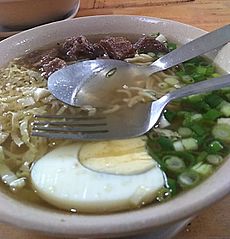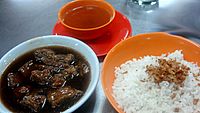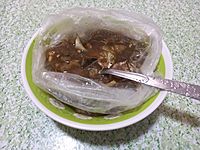Pares (food) facts for kids
|
Top: Beef asado pares, Bottom: Pares kanto
|
|
| Place of origin | Philippines |
|---|---|
| Region or state | Quezon City |
| Created by | Lolita Tiu |
| Invented | 1979 |
| Serving temperature | Hot |
| Main ingredients | Clear Soup (commonly beef-based broth) Sinangag Beef Asado (or any other viand) |
| Variations | Pares Kanto or Pares Kariton, Pares Mami |
Pares (pronounced: PAH-ress), also known as beef pares, is a super yummy Filipino meal. It's a mix of tender braised beef stew, tasty garlic fried rice, and a warm bowl of clear soup. You'll often find this popular dish at special roadside restaurants called Pares Houses. These places are famous for serving up delicious pares meals.
Lately, pares has also become a favorite in small local eateries. These are known as karinderya or carinderia. They offer affordable and delicious meals for everyone. Sometimes, Pares can also mean any dish cooked in a sweet-soy sauce style, like a stew.
Contents
What Does "Pares" Mean?
The name Pares comes from a carinderia called Jonas. It was started by Lolita Tiu and Roger Tiu in 1979. Their restaurant was on Calle Retiro, which is now N.S. Amoranto Street. The word Pares literally means "pairs" in English. This is because the meal "pairs" the beef dish (called ulam) with garlic fried rice and a light beef soup. Together, they make a complete and satisfying meal!
What's in a Plate of Pares?

Beef pares is a meal with three main parts. First, there's beef asado, which is beef stewed in a sweet-soy sauce. Second, you get delicious garlic fried rice. And third, a comforting bowl of beef broth soup.
The Soup in Pares
The soup often comes from the same broth used to cook the beef. The beef simmers in this broth until it's super tender. Then, it's seasoned with the sweet-soy sauce. Sometimes, the soup is made separately using beef bouillon cubes. Cooks usually season this soup with onion, garlic, peppercorns, chives, and onion leeks. Some even add bay leaves to make the flavor even better!
Different Kinds of Pares
There are a few fun variations of pares to try.
Pares Kariton or Pares Kanto
One type is informally called pares kariton or pares kanto. Kariton means "pushcart" and kanto means "street corner." This is because mobile vendors often sell it from pushcarts on the roadside. In this version, the beef and broth are combined. The broth is usually a little thicker because of cornstarch. This pares is less sweet and has fewer spices than the beef asado type. But it's super savory! That's because it often uses beef tendons (litid), bone marrow (utak ng buto), and fatty cuts of beef.
Pares Mami
Another common way to enjoy pares is as beef pares mami. This dish combines pares with mami, which is a Filipino egg noodle soup. It's made similarly to pares kanto, but with noodles instead of rice. People say its taste is a bit like the famous Vietnamese pho soup.
Toppings and Sides
Before serving, chopped green onions and fried garlic bits are often sprinkled on top. This adds extra flavor and crunch! While garlic fried rice is common, some people prefer steamed rice. It just depends on what you like! Some Filipino restaurants even let you have noodles instead of rice with your pares.



